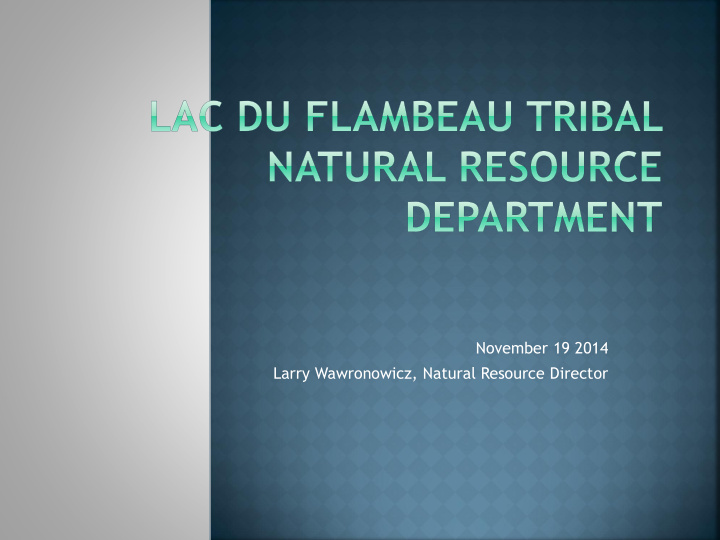



November 19 2014 Larry Wawronowicz, Natural Resource Director
AREA- 86,630 acres or 144 square miles LAND OWNERSHIP- 66.8% tribal land and 33.2% fee land. LAKES- 260. CREEKS/RIVERS- 71 miles. WETLANDS- 24,000 acres FORESTED LANDS- 41,733 acres
The Lac du Flambeau Band utilizes the natural resources to provided cultural, subsistence, economic and social opportunities for tribal members. The resources are also available to the non- Indian Community.
Article 6 (1) (a) of the Band’s Constitution gives the Tribal Council the authority to protect and conserve tribal natural resources.
Protect Conserve Enhance Tribal Natural Resources for present and future generations of all people living on the reservation by utilizing the Band’s IRMP and Natural Resource Programs.
Fish Culture Fisheries Management Wildlife Management Conservation Law Enforcement/Emergency Management/Animal Control Forestry Water Resources
Parks and Recreation Environmental Protection Environmental Response Land Management Tribal Historic Preservation Energy (Alternative and Conservation) Air Program Great Lakes Restoration Initiative
Goal : To raise the fish necessary to support a subsistence and sport fisheries. Fish Raised are Walleye, Muskellunge, Lake Sturgeon and Trout Have raised and stocked over 5 hundred million and 2.9 million walleye fry and fingerlings since 1960.
Goal: Conduct studies and surveys necessary to determine the status of the fisheries resources. Studies and surveys include electrofishing, creel surveys, population estimates, hydro- acoustics, gill netting, etc.
Goal: Conduct studies and surveys to determine the status of the wildlife populations on the reservation. Studies and surveys include deer pellet group survey, bear population survey, grouse, hare, waterfowl and turkey.
50 Bear Survey 1986-2013 45 40 35 % of the Bear Stations Hit 30 25 20 15 10 5 0 1986 1987 1988 1989 1990 1991 1992 1993 1994 2002 2003 2004 2005 2006 2007 2008 2009 2010 2012 2013 YEAR
Goal: To enforce all Tribal Natural Resource laws, codes and ordinances. Examples: shoreline protection ordinance, boating, snowmobile and A.T .V. ordinances, fish and wildlife codes and water quality standards. Animal Control Emergency Management.
Goal: To develop and improve timber stands, timber sales and conduct tree planting activities. The Forestry Program is responsible for managing 41,733 acres of land.
Goal: To develop and improve outdoor recreational opportunities for tribal members and visitors. Operate and maintain the Tribal Campground Implement LDF Parks Plan.
Goal: To improve the environmental quality of the reservation and to educate the community on these issues. Environmental Response Issues include solid waste, air quality and underground storage tank removal Environmental education materials to include videos, brochures and booklets NEPA Review, Site Assessments, Data Collection and Reporting.
Goal: Conduct studies and surveys on reservation waters and wetlands to set water quality standards and monitor the reservation surface and ground water. Educate the LDF Community on water resource issues. Treatment as a State designation to set water quality standards. Implement the Lake Classification System and associated Federally approved Water Quality Standards
Lake Classification Well Head Protection Shoreline Development and Restoration
Goal: Implement the Land Use Plan and Green Sheet Process which assures compliance with Natural and Cultural Codes and Ordinances. Issues permits for housing, roads and other construction or tribal program projects. Purchases lands and homes on the reservation. Places land into trust. Surveys Reservation Lands. Implements the Leasing Program.
Goal: Protects and Preserves cultural and traditional sites and artifacts for present and future generations. Conducts Archeological Surveys on reservation lands. Assists the Tribe in complying with Historic Preservation Act and National Environmental Policy Act. Has the same duties and responsibilities as the State Historic Preservation Office.
Goal: Is to create an Energy Plan for the LDF Reservation that includes conservation and utilization of alternative/renewable energy. Solar, wind, mini-hydro, geothermal and biomass. Develop baseline data on Reservation energy utilization. Determine the potential of alternative/renewable energy for the reservation.
A new program designed to collect baseline air quality data for the reservation. This program will work closely with the Water Resource, Environmental and Fish and Wildlife Programs to help protect air, land and water resources on the reservation.
Wild Rice Restoration Core Samples on Reservation Lakes Wild Rice Specific Water Samples Geo Dome Aquaponics
Some Natural Resource Conflicts/Issues 1. Mining 2. Climate Change 3. Energy 4. Shoreline Development 5. Aquatic/Terrestrial Invasive Species 6. Urban Sprawl 7. Economic Development/Industrial Pollution
Must Encourage! 1. Smart Growth 2. Sustainable Development 3. Sustainable Jobs 4. Energy Conservation Planning 5. Alternative Energy Development 6. Healthy Fish and Wildlife Populations 7. Healthy Forest Ecosystems 8. Clean Water, Land and Air 9. Green Tax Incentives 10. Green Zoning Ordinances
Recommend
More recommend